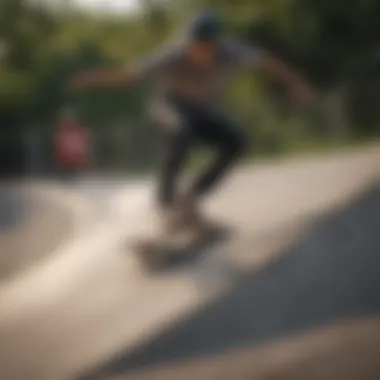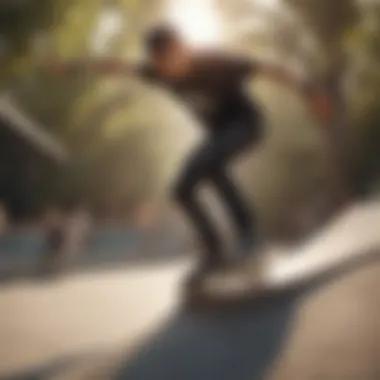Mastering Skateboarding: Navigating Through Skate Obstacles with Skill and Precision


Skateboarding News Updates
As we delve into the intricate world of skateboarding obstacles, staying updated on the latest skateboarding news is crucial. Whether it's recaps of thrilling skate competitions, insights into new product launches shaping the industry, or in-depth coverage of upcoming skateboarding events, being informed keeps us at the forefront of this dynamic sport.
Trick Tutorials and Guides
To master the art of navigating through skate obstacles, understanding trick tutorials and guides is paramount. From breaking down beginner tricks step by step to offering advanced trick tips for the daring skaters, exploring freestyle and street skate techniques provides a solid foundation for conquering obstacles with finesse.
Skateboarding Culture and Lifestyle
Apart from the technical aspects, skateboarding is deeply rooted in a unique culture and lifestyle. Shedding light on influential skateboarding personalities through spotlights, dissecting skatepark reviews for hidden gems, and tracking the ever-evolving fashion trends within the skateboarding community, unearths the essence of this vibrant subculture.
Gear Reviews and Recommendations
Equipping oneself with the right gear is indispensable for seamlessly maneuvering through skate obstacles. From scrutinizing skateboard deck reviews to comparing different truck and wheel options for optimal performance, along with essential suggestions on protective gear, making informed choices elevates the skateboarding experience.
Healthy Lifestyle for Skaters
Sustaining optimum performance on the skateboard demands a commitment to a healthy lifestyle. Discovering injury prevention exercises to safeguard against common skate-related injuries, engaging in skateboard-specific fitness and strength training to enhance endurance, and exploring tailored nutrition tips to fuel the body efficiently empower skaters to excel both on and off the board.
Introduction
Skateboarding, a vibrant and dynamic sport, involves a myriad of obstacles that skaters must conquer. This article immerses readers in the intricate world of skate obstacles, providing profound insights into maneuvering through challenges on a skateboard. Importance of Introduction: Skateboarding is an artform that requires a blend of skill, creativity, and fearlessness. Understanding how to navigate obstacles is crucial for skateboarders striving to enhance their performance and push the boundaries of their capabilities.
Overview of Skate Obstacles
Defining Skateboarding Obstacles
Defining Skateboarding Obstacles is fundamental in comprehending the diverse challenges skaters encounter. These obstacles encompass a range of structures and elements that skaters need to navigate with finesse. Mastering these obstacles is essential for honing one's skills and gaining credibility in the skateboarding community.
Importance of Mastering Obstacles
The Importance of Mastering Obstacles lies in the development of a skater's technical prowess and mental resilience. Overcoming obstacles not only boosts confidence but also fosters a sense of accomplishment and progression within the sport. By mastering obstacles, skaters can elevate their performance and push their limits further.
Evolution of Skateboarding Obstacles
The Evolution of Skateboarding Obstacles showcases the dynamic nature of skate culture. From rudimentary obstacles to cutting-edge designs, the evolution reflects the evolving trends and demands of skaters worldwide. Understanding this evolution provides insight into the history and development of skateboarding as a sport.
Types of Skate Obstacles
Rails and Ledges


Rails and Ledges present skaters with opportunities for technical maneuvers and stylish grinds. These obstacles demand precision and balance, challenging skaters to execute tricks with grace and control. Mastering rails and ledges enhances a skater's versatility and creativity on the board.
Stairs and Handrails
Stairs and Handrails offer skaters a chance to showcase their courage and skill with daring tricks and jumps. Negotiating stairs and handrails requires precision timing and unwavering focus, making it a thrilling yet demanding aspect of skateboarding culture.
Ramps and Bowls
Ramps and Bowls provide skaters with the exhilarating experience of catching air and maneuvering through curves. Skating ramps and bowls necessitates agility and speed, allowing skaters to unleash their aerial prowess and seamless transitions between tricks.
Curbs and Benches
Curbs and Benches test a skater's ability to balance and control their board in tight spaces. Slides and manuals on curbs challenge skaters' technical finesse, while nose and tail tricks on benches showcase their adaptability and creativity in utilizing urban landscapes.
Each type of skate obstacle offers unique challenges and rewards, shaping a skater's journey towards mastery and innovation on the board.
Essential Skills for Overcoming Obstacles
Essential Skills for Overcoming Obstacles play a pivotal role in mastering skateboarding obstacles. These skills are the foundation upon which skaters build their expertise, enabling them to navigate through various challenges with finesse and precision. Developing these essential skills is crucial for any skateboarder looking to enhance their performance and tackle obstacles effectively. By honing these skills, skaters can elevate their abilities and conquer even the most daunting skateboarding obstacles.
Balance and Stability
Balance and Stability are fundamental aspects of skateboarding that significantly impact a skater's control and maneuverability. Achieving a harmonious balance and stability allows skaters to execute tricks with more confidence and precision. Among the core elements that contribute to balance and stability are Core Strength Training and Foot Positioning Techniques.
Core Strength Training
Core Strength Training focuses on strengthening the core muscles, including the abdomen, lower back, and hips. These muscles are essential for maintaining balance and stability while performing tricks on the skateboard. By engaging in specific core strength exercises, skaters can enhance their overall athleticism and stability, enabling them to tackle obstacles with greater control.
Foot Positioning Techniques
Foot Positioning Techniques involve the placement of the feet on the skateboard, affecting a skater's balance and control. Understanding the optimal foot positioning for different tricks and maneuvers is critical for achieving stability and executing tricks effectively. By mastering foot positioning techniques, skaters can enhance their performance and navigate through obstacles with precision.
Precision and Control
Precision and Control are paramount in skateboarding, allowing skaters to execute tricks accurately and with finesse. Skaters who possess exceptional precision and control can navigate through obstacles seamlessly, showcasing their expertise and skill. Key elements that contribute to precision and control include Practice Drills for Precision and Controlling Speed and Momentum.
Practice Drills for Precision
Practice Drills for Precision involve repetitive exercises that focus on perfecting the execution of tricks with accuracy. These drills help skaters refine their techniques, fine-tuning their movements to achieve precision in their maneuvers. By consistently practicing precision drills, skaters can elevate their performance and tackle obstacles with meticulous accuracy.
Controlling Speed and Momentum
Controlling Speed and Momentum is essential for maintaining balance and control while skating through obstacles. Skaters must master the art of adjusting their speed and managing momentum to perform tricks smoothly and flawlessly. By honing their control over speed and momentum, skaters can navigate obstacles with confidence and precision.


Adaptability and Creativity
Adaptability and Creativity are crucial skills that enable skaters to innovate and overcome challenges in unique ways. Skaters who can adapt their skills to different obstacles and think creatively can excel in navigating through diverse skateboarding environments. Core elements of adaptability and creativity include Thinking Outside the Box and Adapting Tricks to Different Obstacles.
Thinking Outside the Box
Thinking Outside the Box encourages skaters to explore unconventional approaches and solutions to skate obstacles. Skaters who can think innovatively can discover new ways to conquer challenges and enhance their performance. By pushing the boundaries of conventional thinking, skaters can unlock their creative potential and tackle obstacles with ingenuity.
Adapting Tricks to Different Obstacles
Adapting Tricks to Different Obstacles involves modifying and adjusting tricks to suit various skateboarding challenges. Skaters must adapt their techniques to different obstacles, considering factors such as size, shape, and terrain. By developing the ability to adapt tricks to diverse environments, skaters can expand their skill set and conquer obstacles with versatility and flair.
Navigating Specific Obstacles
In this section, we delve into the critical aspect of navigating specific obstacles while mastering the art of skateboarding. Understanding how to navigate different obstacles is crucial for skateboarders as it hones their skills and expands their capabilities on the board. By focusing on specific elements such as precision, adaptability, and creativity, skaters can improve their overall performance and approach obstacles with confidence and skill.
Mastering Rails and Ledges
Approaching Grinds and Slides
When it comes to approaching grinds and slides, skaters must master their technique and balance to execute these maneuvers successfully. The key characteristic of approaching grinds and slides lies in the controlled movement and precise footwork required to lock in tricks on rails and ledges. This technique is popular among skateboarders for its ability to showcase skill and creativity in navigating obstacles, giving riders a sense of accomplishment when executed flawlessly. However, the challenge of maintaining balance and coordination while grinding or sliding is a common hurdle that skaters face when perfecting this skill.
Techniques for Locking in Tricks
Techniques for locking in tricks involve the methodical approach to securing a trick or maneuver on rails and ledges. The key characteristic of this technique is the focus on body positioning and weight distribution to maintain control and stability while on the obstacle. Skaters often find this technique beneficial as it allows them to execute tricks seamlessly and with precision, adding style and finesse to their skateboarding repertoire. Despite its advantages in enhancing trick execution, skaters may struggle with the initial learning curve and the risk of error when attempting complex tricks.
Conquering Stairs and Handrails
Advanced Techniques for Skating Mastery
In the realm of skateboarding, mastering advanced techniques is paramount to elevate one's skills and performance. This section delves into the intricate details of advanced techniques that are essential for every aspiring skateboarder looking to push their limits and reach new heights. Advanced techniques go beyond the basics, requiring a deep understanding of precision, timing, and creativity. By honing these techniques, skaters can stand out in the skateboarding community and showcase their prowess on different obstacles.
Combining Tricks on Multiple Obstacles
Sequence Planning and Execution
The art of sequence planning and execution plays a crucial role in a skateboarder's ability to seamlessly combine tricks on multiple obstacles. This involves strategizing and choreographing a series of tricks with precision and fluidity. Skaters must carefully plan the sequence of tricks to ensure a coherent and visually captivating performance. The key characteristic of sequence planning is the meticulous attention to detail in arranging tricks in a logical and aesthetically pleasing order. This deliberate sequencing not only enhances the overall skateboarding routine but also showcases the skater's creativity and flair. While the advantages of sequence planning are numerous, such as impressing spectators and judges, skaters must also be mindful of the potential pitfalls, such as the risk of errors in execution or repetitive sequences that may diminish the impact of the performance.
Maintaining Flow and Consistency
Maintaining flow and consistency while combining tricks on multiple obstacles is a fundamental aspect of skateboarding mastery. Flow entails the seamless transition between tricks, ensuring a continuous and connected performance. Consistency, on the other hand, emphasizes the ability to execute tricks flawlessly and repeatedly. The key characteristic of maintaining flow and consistency lies in the skater's ability to adapt to different obstacles while maintaining a consistent style and rhythm. This requires immense practice, focus, and muscle memory to execute tricks effortlessly. The benefits of maintaining flow and consistency are evident in the skater's ability to captivate the audience with a smooth and dynamic routine. However, skaters must also be wary of the challenges, such as fatigue or mental blocks, that can disrupt their flow and consistency during a performance.
Exploring Unconventional Obstacle Approaches


Delving into unconventional obstacle approaches opens up a world of possibilities for skateboarders seeking to challenge traditional norms and infuse creativity into their routines. By exploring unconventional approaches, skaters can break free from conventional techniques and unlock new avenues for self-expression and innovation on their boards.
Using Environmental Elements Creatively
Harnessing environmental elements creatively involves incorporating the surroundings into skateboarding routines in imaginative ways. Skaters can use ramps, walls, and other structures within their environment to create unique lines and sequences that showcase their adaptability and resourcefulness. The key characteristic of using environmental elements creatively is the ability to see ordinary surroundings as opportunities for creativity and exploration. This approach not only adds depth and originality to a skater's performance but also challenges them to think outside the box and adapt to diverse skate settings. While the advantages of using environmental elements creatively are abundant, skaters must also navigate potential drawbacks, such as limited access to suitable environments or safety concerns associated with unconventional approaches.
Incorporating Street Culture Influences
Incorporating street culture influences into skateboarding routines can infuse authenticity and relevance into a skater's style. Street culture encompasses various urban art forms, music, fashion, and attitudes that have traditionally influenced skateboarding. By integrating street culture influences, skaters can connect with the roots of skateboarding and pay tribute to the community and history that have shaped the sport. The key characteristic of incorporating street culture influences is the embodiment of a raw and edgy aesthetic that reflects the ethos of urban street life. This integration adds a layer of depth and richness to a skater's performance, resonating with audiences familiar with street culture. While the benefits of incorporating these influences are significant in establishing a unique identity, skaters must also navigate the challenge of maintaining authenticity and respect for the origins of street culture within their routines.
Safety Measures and Injury Prevention
Ensuring safety in skateboarding is paramount to avoid potential risks and injuries. By incorporating proper safety measures and injury prevention techniques, skateboarders can enjoy their sport while minimizing the chances of accidents that could hinder their performance or lead to serious harm. This section delves into the essential elements necessary to protect oneself while pursuing the exhilarating thrills of skating.
Protective Gear Essentials
Helmet and Pads
When it comes to protective gear, helmets and pads play a crucial role in safeguarding skateboarders against head injuries and impacts on other vulnerable body parts. Helmets are designed to absorb and dissipate the force of impact, reducing the severity of head trauma in case of falls or collisions. Pads, including knee, elbow, and wrist guards, offer cushioning and protection to joints and bones, reducing the risk of fractures and abrasions. The durable construction and impact-resistant materials used in helmets and pads make them indispensable accessories for any skateboarder seeking to stay safe while pushing their limits on the board.
Choosing the Right Footwear
Selecting appropriate footwear is essential for skateboarding as it directly influences performance and safety. Skate shoes are specially designed with reinforced stitching, padded collars, and sticky rubber outsoles to provide enhanced grip, durability, and board feel. The flat sole and cushioning of skate shoes offer stability and impact protection, allowing skaters to execute tricks with precision and confidence. Choosing the right footwear tailored to the demands of skateboarding enhances comfort, control, and overall skateboarding experience, pivotal factors in preventing foot-related injuries and ensuring optimum performance.
Warm-Up and Cool-Down Routines
Prioritizing warm-up and cool-down routines is key to preparing the body for physical exertion and aiding in post-activity recovery. Proper warm-up exercises, including dynamic stretching, improve circulation, flexibility, and joint mobility, reducing the risk of muscle strain or sprains during skate sessions. Incorporating relaxation techniques post-skate, such as deep breathing, gentle stretching, or foam rolling, promotes muscle recovery, decreases soreness, and enhances overall well-being. By integrating these structured routines into their skateboarding regimen, athletes can optimize performance, prevent injuries, and prolong their longevity in the sport.
Dynamic Stretching Exercises
Dynamic stretching involves moving body parts through a full range of motion in a controlled manner, activating muscles and enhancing blood flow before engaging in intense physical activity. This form of stretching improves muscle elasticity, coordination, and performance, reducing the likelihood of muscular injuries during skateboarding maneuvers. Dynamic stretches target specific muscle groups used in skateboarding, preparing them for the dynamic movements and impact associated with tricks and maneuvers, ensuring a safer and more efficient skateboarding experience.
Relaxation Techniques for Recovery
Following a skateboarding session, implementing relaxation techniques for recovery is essential to promote muscle regeneration, reduce fatigue, and prevent injury recurrence. Relaxation techniques, such as deep breathing, progressive muscle relaxation, or meditation, help alleviate muscle tension, mental stress, and promote overall relaxation. By dedicating time to recovery and relaxation post-activity, skateboarders can enhance their recovery process, mitigate muscle soreness, and maintain peak physical condition for future skateboarding endeavors.
Conclusion
In the realm of skateboarding, the conclusion serves as a crucial element encapsulating the essence of mastering skate obstacles. It ties together the insights and practical knowledge discussed throughout the article. Understanding the significance of navigating through skate obstacles can revolutionize a skater's performance and overall experience. By embracing challenges with confidence and pushing boundaries to set ambitious goals, skateboarders enter a continuous cycle of growth and improvement. Mastery over obstacles is not merely a skill but a mindset that resonates with each rider's journey towards excellence. The conclusion reaffirms the perpetual evolution and adaptation required in the pursuit of skateboarding mastery.
Mastering Skate Obstacles: A Continuous Journey
Embracing Challenges with Confidence
Embarking on the journey of mastering skate obstacles entails embracing challenges with unwavering confidence. This aspect plays a pivotal role in a skater's progression by instilling perseverance and resilience. Cultivating the mindset to confront obstacles head-on fosters personal growth and skill enhancement. The key characteristic of embracing challenges with confidence lies in the ability to navigate uncertainties and setbacks with determination. It is a invaluable choice for this article as it emphasizes the psychological aspect of overcoming obstacles, not just the physical techniques. The unique feature of embracing challenges with confidence is its transformative power, turning impediments into stepping stones for success. This approach, though demanding, reaps countless advantages in enhancing a skateboarder's resilience and self-assurance throughout their journey.
Pushing Boundaries and Setting Goals
Setting goals and pushing one's boundaries are fundamental aspects contributing to the trajectory of mastering skate obstacles. By establishing clear objectives and striving to surpass existing limits, skaters can continually challenge themselves to reach new heights. The key characteristic of pushing boundaries and setting goals is its motivational force, propelling individuals towards excellence and innovation. It is a popular choice for this article due to its direct correlation with achieving success in skateboarding through progressive improvement. The unique feature of pushing boundaries and setting goals lies in its capacity to fuel ambition and drive continuous development. While this approach may present challenges, its advantages in enhancing skills and elevating performance are undeniable, making it a vital component in a skater's quest for mastering skate obstacles.







